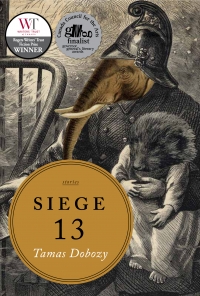Reviews
Fiction Review by Kenneth Radu
Tamas Dobozy, Siege 13 (Toronto: Thomas Allen & Son, 2012). Paperbound, 339 pp., $22.95.

Eastern European countries share a history of horrors during and after World War II. Hungary is no exception, having endured the Nazi invasions and subsequent Russian Red Army counterattacks and occupation of Budapest. Hence the title of Dobozy’s disturbing and often painful-to-read collection: thirteen stories about personal tragedy and unspeakable events. Beyond the immediate catastrophe—and scarcely a story is without episodes of inhumanity and brutality—Dobozy explores the corroding effects of memory, guilt, and atrocity in the lives of survivors and younger generations living in Canada (Toronto, Kitchener, Vancouver), the latter born after the mass murder of civilians, the slaughter of soldiers, or the oppressions and deprivations of the Communist regime. Those who suffered through the times bear the burden of history, and there is no forgetting. In the story “Rosewood Queens,” the narrator’s “Aunt” Rose, who symbolically collects individual chess pieces but not entire sets, says of his father, a survivor of Budapest, “this one focus, those unspoken memories, made him insensible to everything else, all the good things that might have been his, and how that obsession, too, would one day seem irrelevant and leave him with nothing, not even remorse over what he’d squandered.”
This sense of irrelevance is the moral issue for the famous children’s author and illustrator in the first story, “The Atlas of B. Görbe.’’ Despite the attack on the World Trade Center in New York, it seems to Görbe that Americans, or Westerners generally, after the first shock and lamentations, are indifferent. They have picked themselves up and gone about their business, seemingly unaffected. To the academic narrator living in New York on a Fulbright scholarship, somewhat disappointed in his own life and career, the Hungarian author with “a reputation for outrage,” Görbe states his contempt: “It happened. It was bad. And afterwards? Well, it will happen again. And in between you forget. You go back to your entertainments and schemes and obsession and carry on. And that,” he said, “is all there is to say about it.” He is wrong, of course, but his perception, distorted by his own personal and historical tragedy, leads him into a private hell and personal competition of sorrows, where the only refuge is self-righteousness: my horror was more horrible than your horror. And I don’t forget. As the story unfolds, perhaps his point of view is justified. Not forgetting the role one played in war or oppression, whether fighting or betraying friends to gain political advantage or just to survive, is evident throughout this powerful book. Guilt in the form of a psychological trauma is conveyed in the original and deeply sad “The Encirclement.” In this story Professor Teleki, a successful lecturer of Hungarian history, is dogged and heckled by the physically blind Sándor who publicly accuses Teleki of lies and betrayal. The unexpected but eminently believable conclusion is a testament to Dobozy’s narrative pacing and astute insight.
One critic remarks in a quotation on the back of this edition that the best stories “have an imaginative richness that makes them seem like compressed novels, evoking complex worlds.” A story is not necessarily superior because it seems like a novel, however compressed or complex. The risk is that the “novelistic” story has been asked to carry too much. There’s a danger of it being freighted with events, details, and a narrator’s comments like an overloaded transport truck that topples its load on the highway and blocks the flow of traffic. Dobozy’s generally vivid prose is not spare or minimalist, but occasionally the sheer weight of excess baggage clogs lengthy sentences, difficult to perfect in any case, and readers may struggle their way to the end. For example, from an interesting and thematically relevant story, “The Restoration of the Villa Where Tíbor Kálmán Once Lived,” we have this packed and incomplete sentence, part of a catalogue of attributes, with its awkward reliance upon a copula verb followed by a secondary time clause: “The shaded gallery, with its columns and ivy, unbearable for him because the only time a smile ever played across Ági’s face was when she stepped out onto it and took in the smells of the garden and sunshine she and half the country had dreamed about in cellars and shelters during the siege, when all they had was the sound of bombs, the slow fog of plaster shaken from the walls and ceiling and floor with every explosion.” In most stories, however, the sentences are more often manageable and graceful than not, and enriched with strong images. Among several fine narratives, including the haunting “The Animals of the Budapest Zoo, 1944 – 1945,” the masterpiece of Siege 13 may well be “The Beautician.” The narrator, a graduate student in search of authenticity for his thesis in Central European Studies, betrays the trust of Holló, the custodian of a Hungarian community center. The custodian, however, wears make-up and discombobulates conventional notions of gender identity. His own story about surviving Hungary is complex and fascinating, and challenges the narrator’s ethics and exploitation of an individual’s experiences.
Stories about guilt, betrayal, and relentless brutality, sparing not even children, can benumb the reader. Dobozy, however, for the most part keeps our attention not only through the speech and personal qualities of his fully human characters, but also through his adroit handling of comedy, albeit dark at times, which has the salutary effect of rendering the unendurable bearable. This is especially true in “The Homemade Doomsday Machine,” suitably placed last in the collection, depicting the unusual preoccupation of a convincing, nine-year-old genius. However grim and dark the memories and events of Siege 13, the lights of compassion and humour in the midst of horror save us all.
—Kenneth Radu









